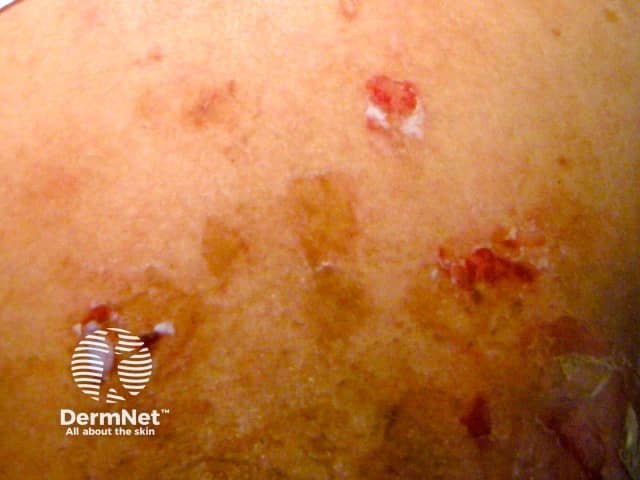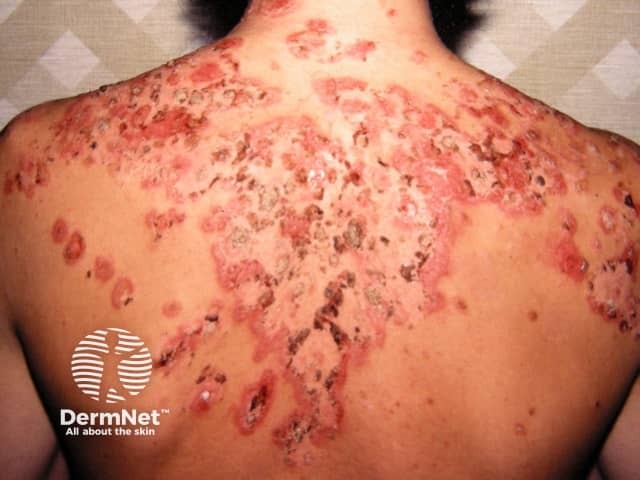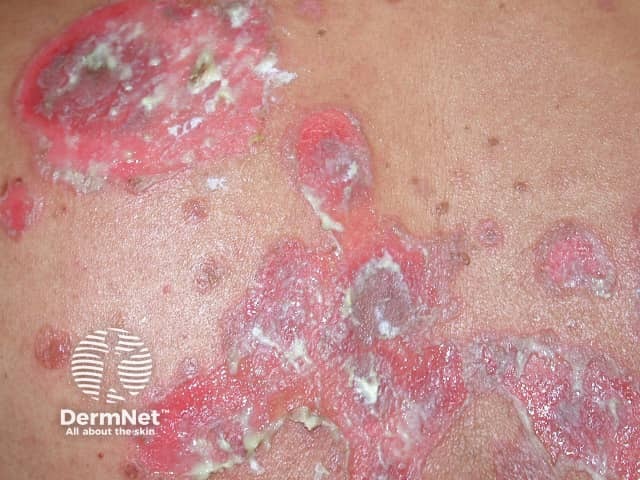Main menu
Common skin conditions

NEWS
Join DermNet PRO
Read more
Quick links
Drug-induced pemphigus — extra information
Reactions Autoimmune/autoinflammatory
Drug-induced pemphigus
Author: Brian Wu, MD candidate, Keck School of Medicine, Los Angeles, USA. DermNet New Zealand Editor in Chief: Hon A/Prof Amanda Oakley, Dermatologist, Hamilton, New Zealand. Copy editor: Maria McGivern. June 2017.
Introduction - pemphigus
Introduction
Demographics
Causes
Clinical features
Diagnosis
Treatment
Outcome
What is pemphigus?
Pemphigus refers to a group of autoimmune diseases that cause blistering. Pemphigus is characterised by the development of antibodies directed against a protein (either desmoglein 1, desmoglein 3 or both) involved in cell-to-cell adherence in the epidermis.
Types of pemphigus include:
- Pemphigus vulgaris
- Pemphigus foliaceus
- Pemphigus erythematosus
- Paraneoplastic pemphigus
- Drug-induced pemphigus.

Drug-induced pemphigus foliaceus

Pemphigus foliaceus

Pemphigus vulgaris
What is drug-induced pemphigus?
Drug-induced pemphigus is diagnosed when a form of pemphigus has been precipitated by a medication. Pemphigus may occur days, weeks, or as long as 6 months after the drug has been commenced.
Who gets drug-induced pemphigus?
Over 200 cases of drug-induced pemphigus have been reported in the medical literature. The reports suggest that patients with drug-induced pemphigus may have similar characteristics to non-drug-induced pemphigus.
- Race — pemphigus may be more common in Jews of Ashkenazi descent
- Sex — more cases were seen in women than in men in some studies
- Age — most of the literature reports on cases seen in individuals between the ages of 30 and 90 years.
In some cases, the drug triggers the re-activation of pre-existing pemphigus in remission.
What causes drug-induced pemphigus?
Drugs that cause pemphigus include:
- Thiol drugs, including penicillamine, captopril
- Antibiotics: penicillins, cephalosporins, vancomycin
- Antihypertensive drugs: other angiotensin-converting enzyme inhibitors such as cilazapril, lisinopril, enalapril
- Piroxicam.
Pemphigus can also be induced by the topical application of drugs such as imiquimod, ketoprofen, neomycin, and bacitracin. Tincture of benzoin and chromium sulphate have also been reported to cause 'contact pemphigus', defined as pemphigus occurring at the site of contact with a topical agent.
Drug-induced pemphigus is usually caused by the induction of an immune reaction to desmoglein proteins and it is identical to the idiopathic forms of pemphigus. In some cases, when no antibodies to desmoglein have been detected, a biochemical cause for the drug-induced pemphigus has been suspected.
What are the clinical features of drug-induced pemphigus?
The clinical features depend on whether the drug-induced pemphigus has been induced by thiol or non-thiol drugs.
Thiol drugs cause pemphigus foliaceus.
- Pemphigus foliaceus presents with erythematous, scaly or crusted plaques.
- Vesicles, bullae and erosions may or may not be present.
- It most commonly affects the trunk.
- The oral mucosa is not involved.
Non-thiol drugs most commonly cause pemphigus vulgaris.
- Pemphigus vulgaris presents with painful flaccid vesicles and bullae.
- It affects the scalp, face and trunk.
- The blistering can affect the oral mucosa.
How is drug-induced pemphigus diagnosed?
The diagnosis of drug-induced pemphigus can be challenging, especially in patients on multiple drugs as the period between the ingestion of the causative drug and the onset of symptoms can be prolonged. Careful, thorough history-taking is vital.
The diagnosis of pemphigus is confirmed by its characteristic intraepidermal blistering when seen on histology of a skin biopsy, and the presence of typical antibodies on direct immunofluorescence. Circulating pemphigus antibodies against desmoglein 1 and/or desmoglein 3 may be detected on serology.
How is drug-induced pemphigus treated?
- Withdrawal of the causative drug
- Systemic corticosteroids
- Immunosuppressive drugs.
What is the outcome for drug-induced pemphigus?
The outcome for drug-induced pemphigus depends on whether the patient has developed antibodies and whether the cause of the condition is a thiol or non-thiol drug.
- Patients whose pemphigus has been induced by non-thiol drugs and have detected antibodies have a better prognosis.
- Around 50% of thiol-induced cases will resolve when the offending drug is discontinued.
References
- Brenner S, Goldberg I. Drug-induced pemphigus. Clin Derm 2011;. 29: 455–7. doi: 10.1016/j.clindermatol.2011.01.016. PubMed
- Darlenski R, Kazandjieva J, Tsankov N. Contact pemphigus: does it exist? Contact pemphigus. Eur J Dermatol. 2020;10.1684/ejd.2020.3916. doi:10.1684/ejd.2020.3916. PubMed
- Korman NJ, Eyre RW, Zone J, Stanley JR. Drug-induced pemphigus: autoantibodies directed against the pemphigus antigen complex are present in penicillamine and captopril-induced pemphigus. J Invest Derm 1991; 96: 273–6. PubMed
- Zhong CS, Hasbun MT, Jones KM, Schmidt BAR, Hussain SH. Pemphigus-like eruption as a complication of molluscum contagiosum treatment with imiquimod in a 5-year-old girl. Pediatr Dermatol. 2020;37(2):379–80. doi:10.1111/pde.14115. PubMed
On DermNet
- Bullous diseases
- Bullous drug eruptions
- Adverse cutaneous reactions to drugs
- Pemphigus vulgaris
- Pemphigus foliaceus
- Oral blistering diseases
- Blistering skin conditions
Other websites
- Drug-induced pemphigus — Medscape
- Pemphigus — The International Pemphigus & Pemphigoid Foundation
- Pem Friends — a UK support group for pemphigoid and pemphigus
Books about skin diseases
